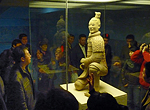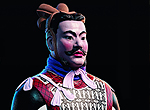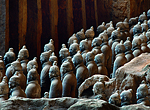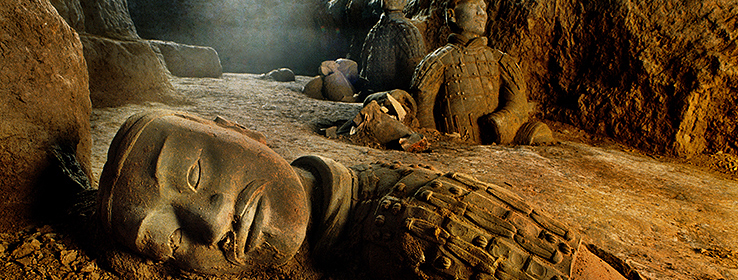Archaeologists explore China’s Terra-Cotta Warriors — and their surprising color story.
By Kim Palmer
The Seven Wonders of the World have been discussed for centuries — but the “eighth wonder” remained completely unknown until it was discovered by accident in 1974. That was a dry year in central China, and drought-stricken farmers were digging a well. Instead of water, they unearthed a human statue, poised for battle. Excavation revealed more than one. There were dozens... hundreds... thousands of figures, a massive army of life-size clay soldiers.
What were they, and why were they there? The farmers had stumbled upon one of the most important archaeological discoveries of all time: The burial complex of Qin Shihuang, China’s first emperor, who died in 210 B.C. The emperor, just a teen when he ascended the throne, wielded enormous power. He united the Chinese empire; started building the famed Great Wall of China; and planned an elaborate eternal resting place for himself, including a great terra-cotta army to accompany him to the spirit world. The soldiers — 8,000 or so in one enormous pit, only a third of which have been excavated to date — represent a small part of a massive complex containing everything the emperor would need or desire in the afterlife, including terra-cotta horses, bronze birds, weapons and chariots.

A palette revealed
Now, more than 2,000 years later, the emperor’s still, silent army attracts approximately 2 million tourists each year, not counting those who flock to a popular touring exhibit. The ancient figures that visitors see today are monochromatic, the natural muted reddish hue of terra-cotta. But they weren’t always so. “All the figures originally were colorfully painted, although on most you don’t see any trace of pigment,” says Liu Yang, curator of Chinese art at the Minneapolis Institute of Arts, which recently hosted the touring exhibit, and author of a companion book, China’s Terracotta Warriors: The First Emperor’s Legacy.
Archaeologists now know, after studying tiny samples of paint residue, that the clay soldiers once displayed a rainbow of bold colors: red, green, purple, blue, yellow, black and white. Not only were the soldiers colorful, they were distinctively so, according to conservation expert Catharina Blansdorf of the Technical University in Munich, Germany, who has worked extensively with the figures. “I did not find two with the same colors,” she told Cosmos magazine.
Do the colorful uniforms accurately represent the emperor’s real-life army, or are they a flamboyant ceremonial expression? “That is still a question to be discovered,” says Liu, although he doubts actual soldiers would have been so colorfully garbed. “The primary color of the Qin dynasty was black,” he notes. “It was the imperial color, of their banners and flags — and most likely their military uniforms.”

Mysterious purple
One hue in particular has fascinated archaeologists. Many of the warriors, especially those that represent high-ranking officers, wear uniforms that once featured purple — a color rarely found on ancient artifacts because it’s not found in surface soils, the source of most ancient pigments.
During the emperor’s era, “colors were mostly mineral colors,” says Liu, with one exception: purple. There were no natural sources for that. Blue and purple pigments emerged only after mining began, according to Cosmos, and even then they were exceedingly rare. While the blue pigment used to color the warriors was naturally occurring, derived from azurite, the purple pigment’s origins are more puzzling. There was an ancient purple dye, extracted from mollusks, but it was so scarce and precious that it became a symbol of wealth and royal status, an association that remains to this day.
In the early 1990s, researchers discovered that the purple found on the terra-cotta warriors is a barium copper silicate. Because it’s also found on artifacts from the later Han dynasty, it’s been dubbed Han purple. Han purple doesn’t occur in nature. Its appearance on the warriors means Chinese artisans were producing it chemically. The ancient Egyptians employed similar methods, raising the question of whether the cultures were exchanging technology much earlier than previously thought. But recently, physicists have determined that Han purple and Egyptian-made hues resulted from different materials and methods, suggesting the Chinese developed pigments independently — perhaps as a byproduct of glassmaking.
We used Chip It!™ to identify the Sherwin-Williams palette worn by this warrior.

Colors erased
Why have the terra-cotta warriors lost so much of their original color? Fire is one reason. The emperor’s clay army appears to have been burnt centuries ago, in its pit. “There is very strong evidence of burn marks,” Liu says. Chinese archaeologists believe the burning probably took place after the emperor died and his party collapsed; the pit was reportedly overtaken by rebels, who probably also made off with many of the warriors’ bronze weapons. The soldiers’ hands were formed to hold swords and spears, but many are empty.
There’s another reason the warriors’ original hues haven’t survived. After the clay was fired, statues were painted with a natural lacquer derived from sap, and then coated with beaten egg as a binder. Natural lacquer and mineral-based paints are extremely susceptible to flaking once they become dried out during and after excavation.
A group of about 110 warriors excavated last year were better-preserved, chromatically speaking, because they came from the bottom of the pit, where mud from a long-ago flood appears to have protected the pigments.
Since 1988, a team of Chinese and German conservators and scientists have been trying to stabilize the warriors’ paint layer, which, without conservation, is lost very quickly after excavation.

“Lucky” red
One dominant color in the warriors’ palette is red, a hue that has symbolized good fortune and joy in Chinese culture. During the Qin dynasty, red was derived from cinnabar, a mineral pigment that produces a hue ranging from cinnamon to bright scarlet. Cinnabar pigment was used widely in tombs, according to Liu. “The connection with this material was longevity,” he says. In addition to using cinnabar as a colorant, ancient people also considered it an elixir, ingesting it in hopes of promoting long life. (In actuality, the mineral — mercuric sulfide — is highly toxic.)

One green soldier
Of the 2,000 terra-cotta soldiers excavated to date, one has a unique characteristic. His face was originally painted green. “He’s the only figure with skin painted that color,” says Liu. The other warriors excavated have revealed more conventional painted complexions: flesh-tone faces with black hair and black or brown eyes.
What’s the significance of the lone green soldier? “There are different explanations, none plausible,” Liu says. Some have speculated that the green-faced warrior soldier was some kind of military shaman. Others have wondered if his skin represents a battlefield disguise, similar to camouflage.
Some have even suggested that painting a soldier’s face green might have been a playful act by one of the emperor’s craftsman. In Liu’s view, this theory is the least likely. During Qin’s reign, “they had tough quality control,” he notes. Bronze weapons and other artifacts were inscribed with the name of the artisan who had crafted them, so determining authorship of the rogue green warrior would have been extremely easy. “If someone playfully made something, they would have been in big trouble,” he says.
So for now, the green-faced soldier remains a mystery — one of many — still waiting to be revealed.









